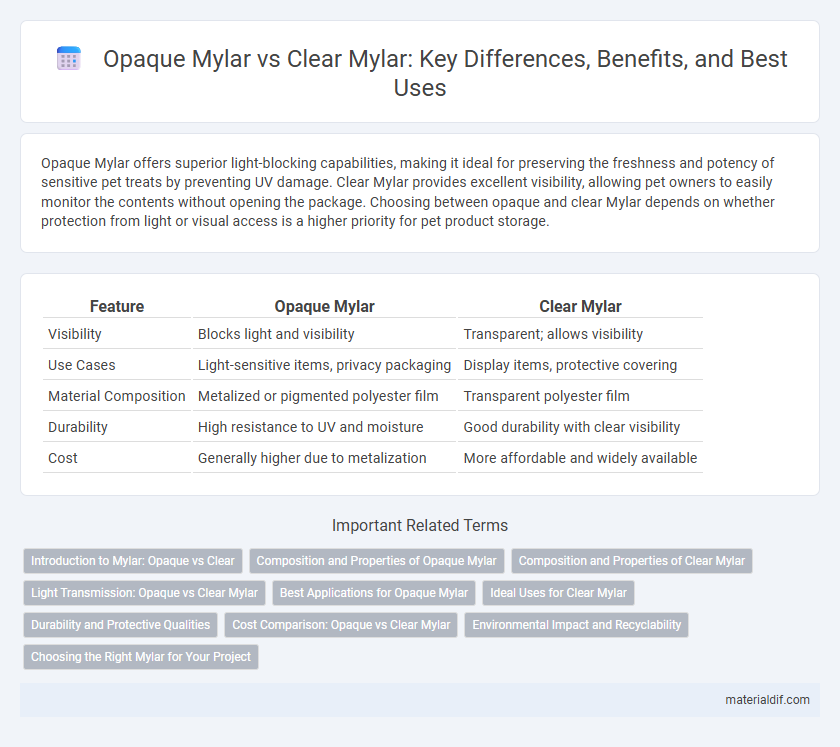Opaque Mylar offers superior light-blocking capabilities, making it ideal for preserving the freshness and potency of sensitive pet treats by preventing UV damage. Clear Mylar provides excellent visibility, allowing pet owners to easily monitor the contents without opening the package. Choosing between opaque and clear Mylar depends on whether protection from light or visual access is a higher priority for pet product storage.
Table of Comparison
| Feature | Opaque Mylar | Clear Mylar |
|---|---|---|
| Visibility | Blocks light and visibility | Transparent; allows visibility |
| Use Cases | Light-sensitive items, privacy packaging | Display items, protective covering |
| Material Composition | Metalized or pigmented polyester film | Transparent polyester film |
| Durability | High resistance to UV and moisture | Good durability with clear visibility |
| Cost | Generally higher due to metalization | More affordable and widely available |
Introduction to Mylar: Opaque vs Clear
Opaque Mylar features a solid, non-transparent surface ideal for blocking light and providing privacy, making it suitable for applications like food packaging and thermal insulation. Clear Mylar offers a transparent, glossy finish that enables visual exposure of contained items, commonly used in decorative wrapping and archival protection. Both types utilize biaxially-oriented polyethylene terephthalate (BoPET) film, valued for its strength, chemical stability, and reflective properties.
Composition and Properties of Opaque Mylar
Opaque Mylar is composed of polyethylene terephthalate (PET) film with a metallic or pigmented coating that blocks light transmission, providing superior opacity compared to clear Mylar. Its molecular structure enhances durability, chemical resistance, and thermal stability, making it ideal for applications requiring light protection and insulation. The reflective surface of opaque Mylar also offers excellent UV shielding and heat reflection properties, distinguishing it from the transparent and flexible characteristics of clear Mylar.
Composition and Properties of Clear Mylar
Clear Mylar is composed primarily of biaxially oriented polyethylene terephthalate (BoPET), which provides excellent clarity and high tensile strength. Its transparency allows for superior visibility while maintaining resistance to moisture, chemicals, and UV radiation. Unlike opaque Mylar, clear Mylar exhibits enhanced optical properties making it ideal for applications requiring light transmission and durability.
Light Transmission: Opaque vs Clear Mylar
Clear Mylar transmits a high percentage of visible light, typically allowing 85-92% light passage, making it ideal for applications requiring visibility and light diffusion. Opaque Mylar blocks light transmission completely, providing total light blockage for privacy, protection from UV rays, or light-sensitive environments. The choice between opaque and clear Mylar depends on whether maximum light transmission or complete light isolation is needed for the specific application.
Best Applications for Opaque Mylar
Opaque Mylar offers superior light-blocking properties compared to clear Mylar, making it ideal for applications requiring complete opacity and protection from UV rays, such as emergency blankets, grow room insulation, and photographic storage. Its reflective surface maximizes heat retention and prevents light leakage, which enhances insulation efficiency in thermal and horticultural uses. The material's durability and moisture resistance further support its use in packaging sensitive electronics and food products that demand light and air barriers.
Ideal Uses for Clear Mylar
Clear Mylar is ideal for applications requiring visibility and protection, such as archival document sleeves, photo preservation, and packaging that showcases the product inside. Its transparency allows for easy identification and inspection while providing moisture and dust resistance. Clear Mylar is commonly used in displays, posters, and protective covers where maintaining visual clarity is essential.
Durability and Protective Qualities
Opaque Mylar offers superior durability due to its thicker, reinforced construction, making it highly resistant to tears and punctures. Clear Mylar provides strong protective qualities by allowing visibility of contents while still offering moisture and UV resistance but is generally less robust against physical damage. Both variations shield materials effectively from environmental factors, yet opaque Mylar excels in harsher conditions requiring enhanced protection.
Cost Comparison: Opaque vs Clear Mylar
Opaque Mylar typically costs less than clear Mylar due to lower manufacturing complexity and material composition. Clear Mylar features premium clarity and enhanced light transmission, which increase production costs and retail prices. Businesses choose opaque Mylar for budget-friendly applications while clear Mylar is preferred where visual transparency is essential despite higher expenditure.
Environmental Impact and Recyclability
Opaque Mylar films typically contain additives and dyes that reduce their recyclability compared to Clear Mylar, which is often more environmentally friendly due to its simpler polymer composition. Clear Mylar is generally favored in sustainable packaging because it can be more easily processed in recycling facilities, minimizing landfill waste. The environmental impact of Opaque Mylar is higher as it often ends up in non-recyclable waste streams, contributing to ecological pollution.
Choosing the Right Mylar for Your Project
Choosing the right Mylar depends on the specific needs of your project, with opaque Mylar offering superior light-blocking and privacy features, making it ideal for applications requiring minimal light penetration. Clear Mylar provides transparency and clarity, which is essential for packaging, protective coverings, and display purposes where visibility matters. Evaluate factors such as light exposure, aesthetic requirements, and protection level to determine whether opaque or clear Mylar is best suited for your use case.
Opaque Mylar vs Clear Mylar Infographic

 materialdif.com
materialdif.com